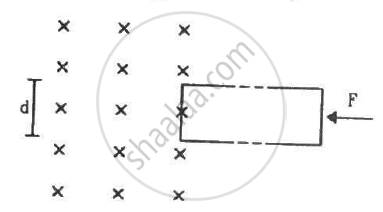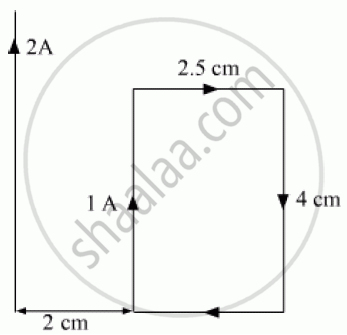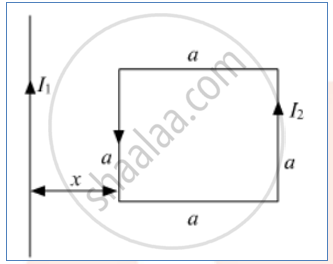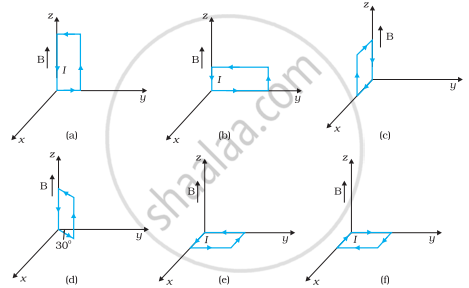Advertisements
Advertisements
Question
The rectangular wire-frame, shown in figure, has a width d, mass m, resistance R and a large length. A uniform magnetic field B exists to the left of the frame. A constant force F starts pushing the frame into the magnetic field at t = 0. (a) Find the acceleration of the frame when its speed has increased to v. (b) Show that after some time the frame will move with a constant velocity till the whole frame enters into the magnetic field. Find this velocity v0. (c) Show that the velocity at time t is given by
v = v0(1 − e−Ft/mv0).

Solution
Given:-
Width of rectangular frame = d
Mass of rectangular frame = m
Resistance of the coil = R
(a) As the frame attains the speed v
Emf developed in side AB = Bdv ...........(When it attains a speed v)
Current = `(Bdv)/R`
The magnitude of the force on the current carrying conductor moving with speed v in direction perpendicular to the magnetic field as well as to its length is given by
F = ilB
Therefore, Force `F_B=(Bd^2v)/R`
As the force is in direction opposite to that of the motion of the frame.
Therefore, Net force is given by
Fnet = F - FB
`F_"net"=F-(Bd^2v^2)/R=(RF-Bd^2v)/R`
Applying Newton's second law
`(RF-Bd^2v)/R=ma`
Net acceleration is given by `a=(RF-Bd^2v)/(mR)`
(b) Velocity of the frame becomes constant when its acceleration becomes 0.
Let the velocity of the frame be v0
\[\frac{F}{m} - \frac{B^2 d^2 v_0}{mR} = 0\]
\[ \Rightarrow \frac{F}{m} = \frac{B^{{}_2} d^2 v_0}{mR}\]
\[ \Rightarrow v_0 = \frac{FR}{B^2 d^2}\]
As the speed thus calculated depends on F, R, B and d all of them are constant, therefore the velocity is also constant.
Hence, proved that the frame moves with a constant velocity till the whole frame enters.
(c) Let the velocity at time t be v.
The acceleration is given by
\[a = \frac{dv}{dt}\]
\[ \Rightarrow \frac{RF - d^2 B^2 v^2}{mR} = \frac{dv}{dt}\]
\[\frac{dv}{RF - d^2 B^2 v^2} = \frac{dt}{mR}\]
Integrating
\[ \Rightarrow \int\limits_0^v \frac{dv}{RF - d^2 B^2 v^2} = \int\limits_0^t \frac{dt}{mR}\]
\[ \Rightarrow \left[ \ln(RF - d^2 B^2 v) \right]_0^v = - d^2 B^2 \left[ \frac{t}{Rm} \right]_0^t \]
\[ \Rightarrow \ln(RF - d^2 B^2 v) - \ln (RF) = - \frac{d^2 B^2 t}{Rm}\]
\[ \Rightarrow \frac{d^2 B^2 v}{RF} = 1 - e^{- \frac{d^2 B^2 t}{Rm}} \]
\[v = \frac{FR}{l^2 B^2}\left( 1 - e^{- \frac{B^2 d^2 v_0 t}{R v_0 m}} \right)\]
\[v = v_0 (1 - e^{- Ft/ v_0 m} ) ............\left[ \because F = \frac{B^2 d^2 v_0}{R} \right]\]
APPEARS IN
RELATED QUESTIONS
A square coil of side 10 cm consists of 20 turns and carries a current of 12 A. The coil is suspended vertically and the normal to the plane of the coil makes an angle of 30° with the direction of a uniform horizontal magnetic field of magnitude 0.80 T. What is the magnitude of torque experienced by the coil?
In a chamber, a uniform magnetic field of 6.5 G (1 G = 10–4 T) is maintained. An electron is shot into the field with a speed of 4.8 × 106 m s−1 normal to the field. Explain why the path of the electron is a circle. Determine the radius of the circular orbit. (e = 1.5 × 10–19 C, me = 9.1 × 10–31 kg)
A rectangular loop of wire of size 2 cm × 5 cm carries a steady current of 1 A. A straight long wire carrying 4 A current is kept near the loop as shown. If the loop and the wire are coplanar, find (i) the torque acting on the loop and (ii) the magnitude and direction of the force on the loop due to the current carrying wire.

A rectangular loop of wire of size 2.5 cm × 4 cm carries a steady current of 1 A. A straight wire carrying 2 A current is kept near the loop as shown. If the loop and the wire are coplanar, find the (i) torque acting on the loop and (ii) the magnitude and direction of the force on the loop due to the current carrying wire.

A rectangular loop of size l × b carrying a steady current I is placed in a uniform magnetic field `vecB`. Prove that the torque `vectau`acting on the loop is give by `vectau =vecm xx vecB,`where `vecm` is the magnetic moment of the loop.
A magnetised needle of magnetic moment 4.8 × 10−2 JT−1 is placed at 30° with the direction of uniform magnetic field of magnitude 3 × 10−2 T. Calculate the torque acting on the needle.
Figure shows a conducting circular loop of radius a placed in a uniform, perpendicular magnetic field B. A thick metal rod OA is pivoted at the centre O. The other end of the rod touches the loop at A. The centre O and a fixed point C on the loop are connected by a wire OC of resistance R. A force is applied at the middle point of the rod OAperpendicularly, so that the rod rotates clockwise at a uniform angular velocity ω. Find the force.

A square loop of side 'a' carrying a current I2 is kept at distance x from an infinitely long straight wire carrying a current I1 as shown in the figure. Obtain the expression for the resultant force acting on the loop.

A planar loop of rectangular shape is moved within the region of a uniform magnetic field acting perpendicular to its plane. What is the direction and magnitude of the current induced in it?
A uniform magnetic field of 3000 G is established along the positive z-direction. A rectangular loop of sides 10 cm and 5 cm carries a current of 12 A. What is the torque on the loop in the different cases shown in fig.? What is the force on each case? Which case corresponds to stable equilibrium?

Consider the motion of a charged particle in a uniform magnetic field directed into the paper. If velocity v of the particle is in the plane of the paper the charged particle will ______.
A rectangular conducting loop consists of two wires on two opposite sides of length l joined together by rods of length d. The wires are each of the same material but with cross-sections differing by a factor of 2. The thicker wire has a resistance R and the rods are of low resistance, which in turn are connected to a constant voltage source V0. The loop is placed in uniform a magnetic field B at 45° to its plane. Find τ, the torque exerted by the magnetic field on the loop about an axis through the centres of rods.
- Assertion (A): The deflecting torque acting on a current-carrying loop is zero when its plane is perpendicular to the direction of the magnetic field.
- Reason (R): The deflecting torque acting on a loop of the magnetic moment `vecm` in a magnetic field `vecB` is given by the dot product of `vecm` and `vecB`.
